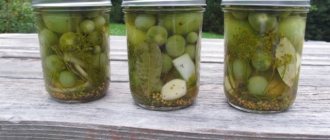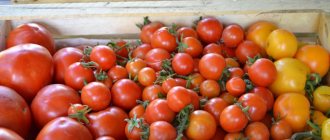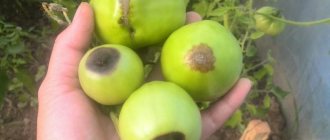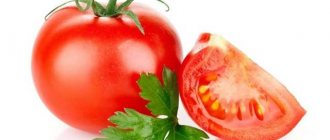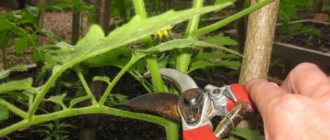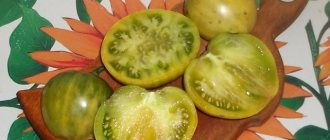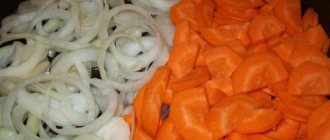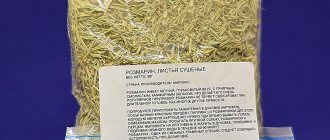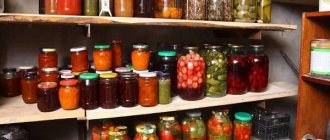Having grown and harvested tomatoes, you want to fully enjoy the result of your labors. However, storing green tomatoes requires a clear understanding of why you are doing it. After all, preserving unripe fruits for a long time, without losing taste, is not easy, since man has not yet fully mastered the mysteries of nature.
When figuring out how to store green tomatoes so that they turn red quickly, and how to delay this process, you will have to delve into complex biochemical reactions.
Purposes of tomato storage
Having collected the crop and delivered it to the place of processing and storage, you need to decide on the following points:
- Should the crop be stored for quick reddening and further processing of tomatoes for the winter, when they can be pickled, pickled, canned, processed into tomato paste, and simply consumed fresh, in salads.
- Either store the tomatoes until the New Year or almost until, but the longer the better.
How to preserve the fruits will depend on which path you choose, so that it is done correctly, competently and with the least loss for the quantity and quality of the product.
Do you know that…
Tomatoes can ripen in a week, or you can stretch out this process for a couple of months. Everything depends on the created conditions.
Harvesting and sorting
Whatever your goal, the event will be successful if:
- tomatoes are collected in a timely manner, without waiting for the time when frost covers the fruits or they undergo frost treatment;
- vegetables collected are of good quality, not blackened by late blight fungus, not damaged (nailed, crushed);
- A dry day was chosen for collection rather than a wet morning.
Since when harvesting there is no time to examine the degree of ripeness and beauty of the circles, when storing at home you need to pay attention to these parameters.
Sorting by degree of maturity must be carried out, since the biochemical processes that have begun cannot be reversed.
So we have:
- green tomatoes;
- beginning to turn brown;
- brown;
- red.
They need to be sorted and the sooner the better. Use reddened ripe ones for immediate processing; there are many methods for this:
- canning;
- pickling;
- drying;
- freezing;
- processing for tomato products.
Brown tomatoes will be first in line for processing when they turn red.
We recommend reading: Ripe tomatoes: how to keep them fresh and process them for the winter.
When and how to collect
Green tomatoes are found not only in open ground, but also in greenhouses. Harvesting depends on the ripening period of the variety. If a tomato variety is characterized by a late harvest of fruits, then they should be collected no earlier than August. The main point is that unripe tomatoes must be collected before frost begins. At low night temperatures (below zero), the taste begins to deteriorate, and the fruit itself begins to rot.
When harvested, tomatoes should reach their size, which is characteristic of the variety; a slight blush may appear on the skin. The fruits are torn off with the stalk and placed in rows in a basket or wooden box. Since the flesh of green tomatoes is quite hard, you don’t have to worry about damaging the skin.
Fruit collection is carried out in dry cloudy weather in the evening or in the morning.
If a tomato bush is infected with late blight, rot or other fungal diseases or viruses, then it is not advisable to collect the tomatoes growing on it. There is a high probability that a diseased tomato will infect a healthy one, and as a result, the entire crop will be ruined. However, if there is a small affected area on the fruit, then before storage it must be scalded with boiling water or placed in hot water at 60-70 degrees. Infections die at high temperatures, and the tomato will be safe and can be eaten.
Varietal features
An important point for conservation is the choice of variety. It is a mistaken belief that any variety can be stored for a long time. Before you set the goal of enjoying your own tomatoes for the New Year holidays, understand the variety of varieties, otherwise you will fail.
We also recommend reading:
Ripe tomatoes: how to keep them fresh and process them for the winter Cabbage: how to prepare and store fresh. Preservation, drying, freezing How to store radishes in the cellar and apartment in winter. Useful preparations for the winter Preserving mushrooms for the winter quickly and without hassle
An event is doomed to failure if:
- when choosing a variety, you did not pay attention to such an indicator as “keeping quality”;
- the beds have become re-sorted;
- During harvest, tomatoes of different varieties were mixed.
If you don’t know what type of fruit you want to preserve, it’s better not to do this, because a tomato that ripens for a long time is tasteless. Even if it is dense and seemingly beautiful, it has an unpleasant smell, taste and a disgusting aftertaste.
Green tomatoes contain solanine, a poisonous alkaloid that gives them an unpleasant taste. Its concentration decreases after fruit ripening or during culinary processing (pickling, fermentation, salting)
It’s a completely different matter when the tomatoes, set to ripen, ripen quickly, and then are processed into amazing preparations that will decorate any holiday table and prove to everyone that you are an excellent housewife. [flat_ab id=”24"]
Do you know that…
A whole army of breeders is working to create tomatoes that last longer and become tastier, sweeter, and more aromatic over time.
Types of varieties for storage
Today, breeders have developed many varieties of tomatoes, which differ (among other things) in their ability to be preserved for a long time.
- The following varieties are capable of staying green for a long time: Vasilisa, Yellow Tomato (another name is Orange Ball), Long Keeper, Giraffe. These varieties are remarkable because, with proper care, they are perfectly preserved until the March holidays.
- The famous varieties withstand long-term storage quite well: Zhanna, New Year's, Rio Grande, Podzimny. They are stored under appropriate conditions for four months.
- Oak, Moonlight, Japanese Crab, New Masterpiece, Novorossiya are stored for only 60 days.
Given the difference in shelf life, it becomes clear that it is undesirable to put different varieties of tomatoes in one container.
How to store tomatoes so they ripen quickly
There is a direct relationship between temperature indicators and the rate of ripening of tomatoes:
- the warmer it is, the faster the ripening;
- the lower the temperature, the slower the ripening.
Naturally, no one will walk around boxes of tomatoes with a thermometer. Everything is done simply:
- Tomatoes are placed in boxes.
- They cover themselves with a towel, rags, even newspapers, as long as bright sunlight does not fall on them.
- The boxes are installed in a warm (with a temperature of about 20 ° C) room in the house.
Where can I find such a place? The kitchen is where products belong.
Do you know that…
Fruits sent for ripening must be of normal size for their variety. Small and underdeveloped ones will not be able to keep up.
Where to store
There are several options for storing green tomato harvests. They can be used in apartments, cottages, and country houses.
Boxes
The material of the container is not important. Cardboard, plastic, and wooden boxes are suitable. The bottom must be covered with several layers of newspapers. Place the tomatoes in layers, each covered with a layer of paper. You can use dry straw if the crop will be stored in a utility room.
Deep drawers are not needed. One should hold no more than 12 kg. Part of the tomato will choke if you put more than 3 layers in a container. The storage location must be easily accessible. Every 3-4 days it is necessary to check the condition of the fruits and select:
- ripe;
- brown;
- rotten.
Tomatoes starting to turn brown should be placed in a separate box. This will slow down the ripening process of green tomatoes and extend the period of their consumption.
Packages
In an apartment, it is convenient to store green tomatoes in paper bags. The fruits can be wiped with a rag soaked in vodka. The absence of infection will extend the storage period. At a temperature of 18-20 °C, the fruits will turn red after 2 weeks; if the room temperature is not higher than 15 °C, the ripening time will increase to 4 weeks.
In the cellar, tomatoes can be stored in plastic bags. There is no need to tie them. The air should circulate freely. It is better to hang the bags. The temperature in the cellar is low, so the tomatoes will ripen slowly. If necessary, the package can be brought into the room. In a warm room they will quickly turn red.
Banks
If you have glass jars, green tomatoes can be ripened in them. Convenient to store in a 3 liter container with a wide neck. The filled container should be closed with a lid and placed in a closet or other dark place.
To speed up ripening, put a banana or a couple of red tomatoes in the jar. The condition of the fruits must be monitored and removed if signs of spoilage appear. At room temperature, tomatoes in jars ripen in 10 days.
Ripe tomatoes can also be stored in a jar. It must be sterilized in a microwave, oven or steam. Wash the selected fruits, wipe dry and place in a prepared container. Prepare the lid, pour 3 tbsp into the jar. l alcohol, set it on fire, close the lid. There will be no oxygen in the jar due to combustion; ripe tomatoes are stored longer in a vacuum.
Fridge
Both ripe and green tomatoes are stored in the vegetable compartment of the refrigerator. For long-term storage they are placed in bags. The fruits are pre-wiped dry. There should be no condensation in the plastic bag.
Ripe tomatoes can be frozen. Cherries and small cream are frozen whole, and large-fruited varieties are cut into slices (circles, quarters, cubes). You can use frozen tomatoes when preparing pizza, meat and vegetable stews, pilaf, and borscht.
How to keep tomatoes longer
If you still decide to save green tomatoes longer, then:
- keep them in a cool place (temperature around 13 °C);
- constantly sort out and put aside those that are beginning to turn brown;
- periodically select and discard those that have begun to turn black.
Where to store these tomatoes:
- a small amount - in the refrigerator;
- the big one is in the basement.
Do you know that…
Whatever storage method you choose, if the tomatoes turn black, there is no point in storing them any longer. Moreover, such tomatoes should not be processed.
Where to put green tomatoes for ripening
Today, there are several time-tested methods for storing green tomatoes for ripening. Before giving preference to any particular method, it is necessary to take into account that the temperature in the room must not be lower than +15°C, the permissible humidity level is 80%. It is important to understand that the higher the temperature, the faster the fruits will ripen and be ready for consumption.
Attention! If you expose green tomatoes to the sun, their appearance will deteriorate.
Myths and reality
If you wander around the Internet, you can read a lot, but each line is worth thinking about:
- “To ripen, tomatoes must be covered with a red cloth.” This is probably outright quackery, although if you want to have your own opinion on this matter, then try it. It is advisable, of course, to keep the experiment clean and cover one box with a red rag and the other, for example, with a green one. And please share your research results in the comments.
- Mustard powder also does not help ripening. If the tomatoes have turned black, it won’t help either.
But it’s true that when you add a ripe apple or one that’s starting to rot to green tomatoes, unripe tomatoes ripen faster.
To speed up ripening, you can also add overripe bananas or pears to green tomatoes.
Do you know what ripe fruits smell like? That's right - delicious. They smell like ethylene with aromatic substances. The riper the fruit, the more gas it releases and contributes to the redness of its neighbors.
Do you know that…
At the beginning of the last century (1936), a work was published at the Peterhof Biological Institute on the effect of ethanol (medicinal alcohol) on stored tomatoes. So, when 0.2 ml of vodka was introduced into the pulp of a tomato, first the injection site began to turn red, and then the fruit itself, and evenly. This did not affect the taste.
Ripening of “drunk” tomatoes takes place 10-12 days earlier than “sober” ones. Another interesting fact is that “drunken” tomatoes produce seeds with excellent seedlings.
Why is it necessary to remove unripe tomatoes?
There are several objective reasons; if they exist, experienced summer residents remove unripe tomatoes from the bushes without further hesitation. The reason is both the unpleasant symptoms of a fungal disease (powdery mildew, late blight) and a large harvest.
When signs of disease appear, formed fruits are collected from the bush, and the plant is treated with a fungicide solution. If the bush overcomes the infection, the remaining ovaries will develop safely and the green tomatoes will ripen.
On a note!
Before storing fruits from a diseased bush, they are washed, immersed in water heated to 60 °C for 3 minutes, and wiped dry.
A healthy bush overloaded with fruits may have branches that break. By removing part of the crop, the summer resident reduces the load on the vines. It's not just ripe tomatoes that need to be picked. Brown, green fruits that have reached medium to large size are also collected.
Prolonged bad weather (rain) can lead to tomatoes cracking and rotting. Preserve the harvest by timely harvesting and proper storage. Don't delay picking tomatoes in August when the nights get cold.
The signal for harvesting is the appearance of the first yellow leaves on the bushes. Fruits picked at the right time are stored longer, do not rot, and ripen well. In cold weather, tomatoes at home will turn red faster than on the bushes.
Tomato processing
If it is not possible to keep tomatoes fresh for a long time at home, they are processed. Recipes for all kinds of preparations can be found for both red and brown and green tomatoes.
Preparing tomatoes for the winter using a proven recipe is not difficult. Or you can experiment and dry it, roll it with mustard, and process it into sauces and salads.
Try preparing a very tasty salad for the winter using the recipe from this video:
Many factors influence how to store tomatoes at home. However, you will be able to extend the shelf life of this wonderful vegetable and enjoy eating it in fresh and processed form.
Store correctly and be healthy!
Reasons why tomatoes do not have time to ripen
In addition to the fact that early cold weather prevents tomatoes from turning red in the garden, there are a number of factors that prevent vegetables from ripening on time:
- A variety unsuitable for a given climate;
- Improper care of tomatoes;
- Late planting of seedlings in the ground;
- Lack of sunlight.
In any case, whatever the reason that the tomatoes did not ripen on time, the fruits must be preserved, because this is more than one day’s work. You can help the tomatoes ripen outside, or you can pick them and let them turn red at home.


